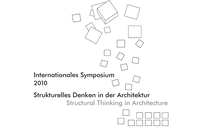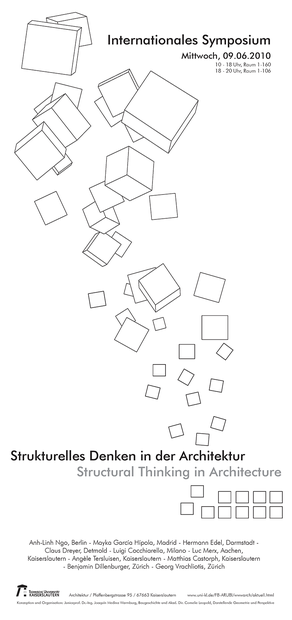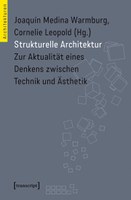Symposium Structural Thinking in Architecture
International Symposium 2010
Structural Thinking in Architecture / Strukturelles Denken in der Architektur
On June 9, 2010, an international symposium on "Structural Thinking in Architecture" took place at the Faculty of Architecture, TU Kaiserslautern. Based on the structuralism currents of the 1960s, especially the cybernetic approach, which refers to mathematical ways of thinking, it was discussed to what extent these approaches can be taken up again today under the aspect of digital tools. Representatives from various disciplines, including the partner universities in Milan (Prof. Dr. Luigi Cocchiarella) and Madrid (Prof. Dr. Mayka García Hípola), presented their research on the topic.
The abstracts were published in a handout.
What is a structure anyway? It is the totality of the elements of a system with their function and their relations. Reference was made to systems theory, which developed these relationships between structure and system. Based on structures of order and the concept of information introduced by Norbert Wiener, the philosopher Max Bense developed an exact aesthetic as early as the 1960s that made it possible to calculate an aesthetic state. Mathematical structural thinking was linked with aesthetics and design. The metasciences such as systems theory, cybernetics, aesthetics and semiotics form the foundation for structural considerations in architecture. The possibilities of this interdisciplinary approach to architecture were examined from the perspective of various disciplines: philosophy, semiotics, linguistics, geometry, art and rule-based design. The theoretical structural approaches in architecture were illustrated using design examples: a modular wall system, an "elastic floor plan" based on a floor plan database, and the complex system of the house as a whole, which is addressed in the new field of house cybernetics with regard to an energy-efficient and resource-saving building design.
In a discussion round in the afternoon the relations between the lectures were established. Two points in particular were discussed:
1. Why have the structural movements of the 1960s no longer been followed up? The reason, according to Hermann Edel, was poorly executed examples of architecture such as the prefabricated concrete slab buildings and the turn of modernism towards art and not towards science.
2. Where can these approaches be taken up today under new aspects? Collecting good examples of architecture and classifying them according to criteria can form the basis for making the distilled structures usable for architectural design with digital tools.
Along with the topic, an exhibition was held in the foyer of our building: "Aesthetic Arrangements", pictures by Hermann Edel, Darmstadt; "Once upon a time there was a cube...", cube disassemblies and new compositions by students of the seminar "Disassembling and Structuring" of the Department of Descriptive Geometry and "Spatial Growth", works by students of the Department of Artistic Design.
The day ended with the lecture "Fritz Haller and the Microchip. Architecture between Structure and Infrastructure" as part of the series Architektur-Positionen. Georg Vrachliotis, then ETH Zurich, now TU Delft, presented the work of Fritz Haller, who is one of the most important representatives of architecture conceived as a (building) system.
The symposium was initiated and organized by Joaquín Medina Warmburg, Department of Architectural History and Cornelie Leopold, Department of Descriptive Geometry.
The lectures were published in the book:
Withs contributions by
Joaquín Medina Warmburg, Cornelie Leopold, Hermann Edel, Mayka García Hípola, Claus Dreyer, Luigi Cocchiarella, Luc Merx, Angèle Tersluisen, Georg Vrachliotis, Matthias Castorph and Benjamin Dillenburger.



 Joaquín Medina Warmburg, Cornelie Leopold (eds.): Strukturelle Architektur. Zur Aktualität eines Denkens zwischen Technik und Ästhetik. Transcript Verlag, Bielefeld 2012
Joaquín Medina Warmburg, Cornelie Leopold (eds.): Strukturelle Architektur. Zur Aktualität eines Denkens zwischen Technik und Ästhetik. Transcript Verlag, Bielefeld 2012